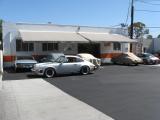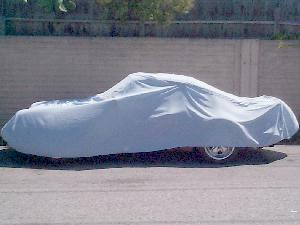
This story is really just like any other. A Porsche with an intermittent running problem. But a Porsche with an intermittant running problem that was difficult to reproduce can be quite a challenge.
In this case, the car was a 1977 Turbo Carerra, with the engine and transmission rebuilt and ready for the owner to pick up. It was freshly detailed and looks great. The Turbo had been at our shop for quite a long time, and the detail was badly needed. So after it came back from the detailer, we took it for one last quick test drive, "just to make sure everything is OK".
On the final test drive we noticed a serious cut out on acceleration. We were pretty busy at the time and could not spend much time with it that day. Over the next few days we each drove the car when we had time, and each of us had different ideas of what was the cause. Unfortunately we also found the problem was intermittent and seemed to go away as the car warmed up. On a hunch, Bob removed the fuel level sender and looked in the fuel tank for problems. Everything looked pretty good.
As I said, intermittent problems are a challenge, but when they involve drivability they are the most challenging we face. This one was turning bad at every step. Some of the ideas we talked about included: fuel pump, ignition coil, CD unit, fuel pump relays, loose electrical connections. Swapping in a new part for a suspect part and test driving is an old practice that is not always a wise idea. Simply touching a relay can cause a bad relay to work again (for a while anyway). Being an intermittent problem, this test can trap a technician into telling the owner 'We think we fixed it". No owner wants to hear that; they want to hear "We ran tests and isolated the cause to part 'X', and now you will be fine". To avoid this trap each test should be done to check an output in the least invasive way possible. Once an output is found to be at fault the diagnostic path can be tracked back to the cause.
So, to start our diagnostics we began with a quick test of the fuel pump current for both fuel pumps, but that turned out fine. We also did a 'Current Ramp' test on both pumps, and that looked good. Concerned the problem being intermittent might only produce a bad current test only when accelerating, we set up up a multimeter for a test drive. To get a measurement of fuel pump current on a road test, we set the meter to record minimum and maximum values. Unfortunately that gave us normal results.
Bob realized he heard the rear fuel pump sound funny the day before. We reluctantly swapped in two new fuel pump relays. A fuel pump relay shutting off one pump will cause the other pump to sound funny. But on the next test drive the car still had the intermittent dramatic shutdown on acceleration.
At this point we decided to confirm the fuel delivery was OK. For this we connected the
Snap-On Vantage, and a Pressure Transducer
connected parallel to the fuel filter outlet. The second channel on the Vantage was set up
with an rpm pickup to watch for an ignition problem. On the road test we confirmed a fuel
problem, and the ignition system appeared OK. The fuel system pressure specification for
this car is 6.0--6.7 bar and was dropping well below normal under boost. Concerned the over
boost pressure switch was sticking and shutting the fuel pumps off, we changed the Vantage
to monitor the over boost switch and fuel system pressure.
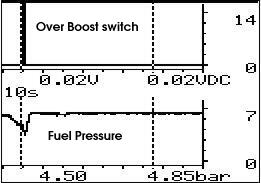
Here the upper trace clearly shows the over boost switch was being triggered, but the
pressure had already dropped to 4.5 bar just before the switch activated. The bad news
here was the Turbo did not experience the dramatic cutoff we had seen intermittently.
We had confirmed the over boost switch did not cause the fuel pressure drop, but now
we had raised even more questions.
1.Why was fuel pressure dropping?
2.Why was the over boost switch activating?
These test results suggests this Turbo may have multiple problems creating similar symptoms.
Our next test was to dual trace the boost pressure and over boost switch activation. (Sorry but I lost the screen shot I had of this.) We found the over boost switch activating at approximately 0.9 bar This may be a bit low, so we may have an issue with excess boost pressure. Unfortunately, again, the car did not experience the intermittent dramatic shutdown. Now we're concerned the over boost protection relay may be at fault. We reluctantly swapped in a new relay. When driving down the alley for this test, the car almost dies, and the fuel pressure shows about 2-3 seconds of fuel pressure very low at about 2.0 bar, and over boost switch shows it did not trigger. Something happened, but what?
Considering what we knew so far, we decided to do a Fuel Volume test. The results showed a fuel volume of 1050cc/30Secs., and was below the factory minimum specification of 1170cc/30Secs. This is about 10% below the minimum and is cause for concern. We removed the fuel filter, checked for plug up, and found that was OK. It should be considering it is new.
At this point one of the two fuel pumps are suspect, but before we went to our next test
it was time to do some quick visual checks of the fuel pump wiring. The wiring looked good,
so we checked differential fuel pressure.
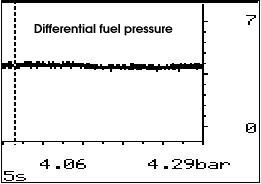
This is a pressure measurement taken between the front pumps output, and the rear
pumps input. This tells us if the front or rear pump is not performing well. Low pressure
signifies the front pump is at fault, high pressure indicates the rear. The specification
is listed as "Between 2.0--4.0 bar", but here we found it hovering at or above the upper
limit of 4 bar. The rear full pump looked to be at fault, so we installed another rear fuel
pump.
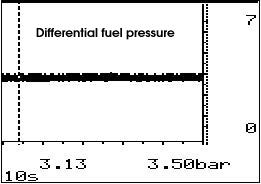
After replacing the rear pump, the differential fuel pressure measured about 3.3 bar and
that was well within specification.
It now looked like the car was fixed in regards to the fuel delivery, but we would confirm that on our next road test. Before we do that, we still were unsure about the over boost cutoff. We checked the workshop manual specs on the over boost switch and found that to be 1.1--1.4 bar. Since the original appears to be out of spec, we ordered a new switch, and moved on to the next step.
We reconnected the Vantage and Pressure Transducer, tapped into the fuel filter outlet port,
as before, and went for another road test.
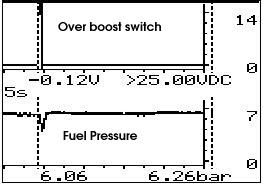 This time we read about 6.5 bar system pressure, which was about the same as our
previous measurement. But what was important to note here is that when the over boost
switch activated, fuel pressure was in spec. The other thing we saw here is that the small
pressure drop off in the lower trace appeared to be caused by the over boost switch.
That is the over boost protection relay shutting the fuel pumps off.
This time we read about 6.5 bar system pressure, which was about the same as our
previous measurement. But what was important to note here is that when the over boost
switch activated, fuel pressure was in spec. The other thing we saw here is that the small
pressure drop off in the lower trace appeared to be caused by the over boost switch.
That is the over boost protection relay shutting the fuel pumps off.
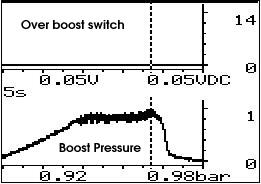
After the new switch was installed we got this reading when dual tracing the over boost switch, and boost pressure. Now that the switch was not shutting off, the boost climbed to about 0.9--1.0 bar. That was a bit higher then stock boost pressure ( 0.7 +- .2 bar ), as we suspected. It appeared this car had a stiffer waste gate spring installed.
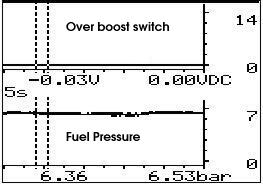 A final check of the boost switch and fuel pressure showed everything is fine.
A final check of the boost switch and fuel pressure showed everything is fine.
And now this 1977 Turbo Carrera was running better then it ever had. With any luck, we will now be able to deliver this pretty Turbo... Or will we?
